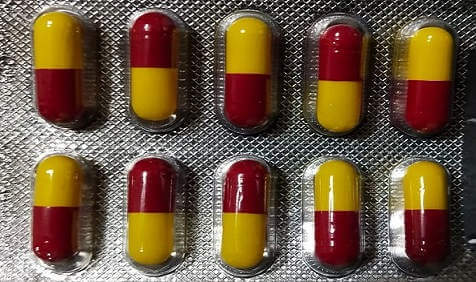Tramadol is an opioid-type pain reliever that can be used to treat moderate to severe pains. I say ‘opioid-type’ because it is not really an opioid, that is it is not derived from real opioids like Oxycodone or Hydrocodone. Here, we shall discuss what makes Tramadol special.
Unlike other opioids, Tramadol does not come from the opium flower. It is fully synthetic and can be produced in the lab. Tramadol has many brand names. The most common is Ultram. Others are Maxitram, Zydol, Zamadol, and Tramquel.
Before we can talk about what makes Tramadol so special, we should understand the types of pain relievers and how they work.
The Types of Pain Relievers
Generally, there are two types of pain relievers in the market- No-opioid and Opioid. Non-opioids are the ones you can buy over the counter such as Acetaminophen. On the other hand, opioids are the ones you need prescriptions for such as Oxycodone.
The common knowledge is that non-opioids deal with low to moderate pains such as headaches and toothaches. Opioids, conversely, are the serious painkillers for serious pains like surgical pains.
Although that is the general idea, there is more to it. We need to understand how they differ when they work in the body.
Pain is triggered by a hormone called prostaglandin. If there is a cut, bruise, or damage to any part of the body, prostaglandin rushes there. It constricts the blood vessels around the damaged area to stop blood from flowing. That’s why there is swelling around a painful area.
The second function of prostaglandin is to signal the brain. It is then we start to feel pain. Our brain knows that there is a problem and takes steps to repair the damage. Therefore, pain is actually very important- no pain, no repair.
Non-Opioid Pain Relievers
Non-opioids, like Ibuprofen or Acetaminophen, work by blocking the flow of prostaglandin. This act increases the pain threshold of the body. It is only a temporary measure and that’s why non-opioids work only for low to moderate pains.
Additionally, if the flow of prostaglandin lowers, our brain also doesn’t do anything to repair the damage. It is alright though. If you have a simple headache or menstrual pains that will go away, you don’t need any repairs. You can use them for toothaches too until you wait for a dentist’s appointment.
However, they can’t deal with severe pains or major cuts. That’s why you never see doctors prescribe Acetaminophen after surgery.
Opioid Pain Relievers
These are the true painkillers. Not only do they withstand severe pain, but they also help repair damages. Here is how they work.
You need prostaglandin to flow if your brain is to repair anything, but it hurts. Instead of trying to stop prostaglandin, opioids change the perception of the brain. They create an altered state where nothing hurts.
It is this reason why opioids are so powerful. In this altered state, the nervous system is numbed. However, the brain still goes on with the repairs. They slow the heart rate down and put the patient into a comatose.
The patient may fall into a deep sleep or in an altered reality (high). It depends. For that reason, opioids are to be administered very carefully under professional supervision. Too much and the patient may never get back to the actual reality.
Also, opioids are, by nature, addictive. Anyone can get hooked within a week of use.
What Makes Tramadol Special?
Now, we can get to the point. Tramadol, also known as Ultram, is in the middle. It is between an opioid and a non-opioid. It is an opioid in the sense that it works by altering the perception of the brain. It is non-opioid in the sense that it is synthetic and is not derived from the opium flower.
Related: Where to Order Tramadol Online
What are the benefits of Using Tramadol?
Here are severe benefits that make Tramadol so Special:
- It can be used for low, moderate, and severe pains.
- It doesn’t make the patients that high. Patients using it can perform normal everyday activities.
- It is an ideal step-down pain reliever that you can use a few days after a major surgery until the pain is totally healed.
- It isn’t addictive like other opioids. It was actually an OTC (Over-the-Counter) medication before. It was only in 2014 that it became an Rx medication.
- Although a Schedule IVdrug in the USA, it is still an OTC in many countries and so it is available for sale online.
- It is produced in the lab and so it is a lot cheaper than other opioids.
To learn more, you can check out our Tramadol FAQ page.
What are the Drawbacks?
Since it is a synthetic drug, it has one drawback. It produces opioid-like effects only after entering the body. A liver enzyme interacts with Tramadol and produces a chemical called ‘M1‘. Only then can its effects be felt.
Therefore, if there are patients with liver conditions that don’t allow the production of M1, Tramadol won’t work for them. They won’t feel anything at all although the chances of that liver condition in patients are less than 5%.
Tramadol Misunderstood
According to Harvard Health Publishing, Tramadol is a misunderstood medication. It was an OTC before, but now it is an Rx medication.
Although the claim was made that Tramadol is addictive, there haven’t been proper studies on this matter. According to Harvard Health, the test that was done on addiction had a contaminated result known to the medical community as ‘confounding’.
Confounding is when the test subjects produce a substandard result because of preexisting conditions. A lot of the patients who took part in the Tramadol test had a history of substance abuse. Therefore, they displayed addictive behaviors.
That’s why Tramadol was Scheduled. More studies are required.
How to Use Tramadol Properly?
Unless you have a liver condition, you are okay to use Tramadol. Yet, it is always best to ask a doctor. Here are a few know-hows:
- There are several dosages: 50 mg, 100 mg, are 150 mg tablets.
- Regardless of the dosage, an average adult should not exceed 400 mg a day.
- A young adult should not exceed 300 mg a day.
- If you feel no effect, your liver is not helping produce M1 so you should ask your doctor and switch to a real opioid.
- You may feel slightly high in the beginning and should not drive or operate heavy machinery. It is better to sleep if you feel sleepy. That’s how the body heals.
- The ‘sleepy’ or ‘high’ effect goes away in a few days and you can resume regular work.
- You can Overdose on Tramadol if you take more than 1000 mg.
- Do not take Tramadol with Alcohol or Marijuana.
- Other medications such as Diazepam (Valium) or Zolpidem (Ambien) can be taken with Tramadol, but ask your doctor for the correct dosages and timings.
- Other non-opioids like Acetaminophen or Ibuprofen can be used in combination with Tramadol, but ask your doctor as well.
- Tramadol should not be addictive, but if you feel dependent, consult your doctor ASAP.
An anxiolytic (Anti-anxiety medication) like Valium works really well in combination with Tramadol. It has an uncanny ability to relax the muscles and relieve stress. This helps the brain repair the damages faster.
Related: Where to Buy Valium Online
The Takeaways
So, what makes Tramadol special? It is a non-opioid opioid that can treat all sorts of pains without the addiction problems. Where Acetaminophen fails, Tramadol will work, and you don’t have to spend a fortune on pain relievers, which is great for those with chronic pains.
We Stand With Ukraine
Want to help the Ukrainian children in their hour of need?
Share this:
- Click to share on X (Opens in new window) X
- Click to share on Facebook (Opens in new window) Facebook
- Click to share on LinkedIn (Opens in new window) LinkedIn
- Click to share on Pinterest (Opens in new window) Pinterest
- Click to share on WhatsApp (Opens in new window) WhatsApp
- Click to share on Tumblr (Opens in new window) Tumblr
- Click to print (Opens in new window) Print


